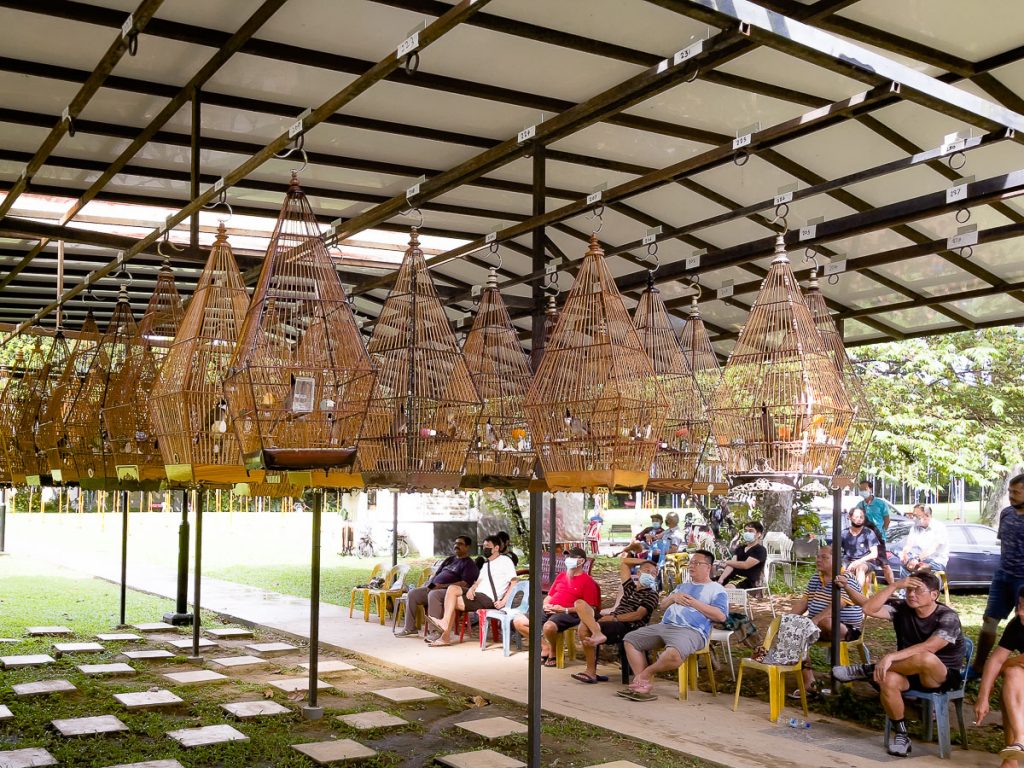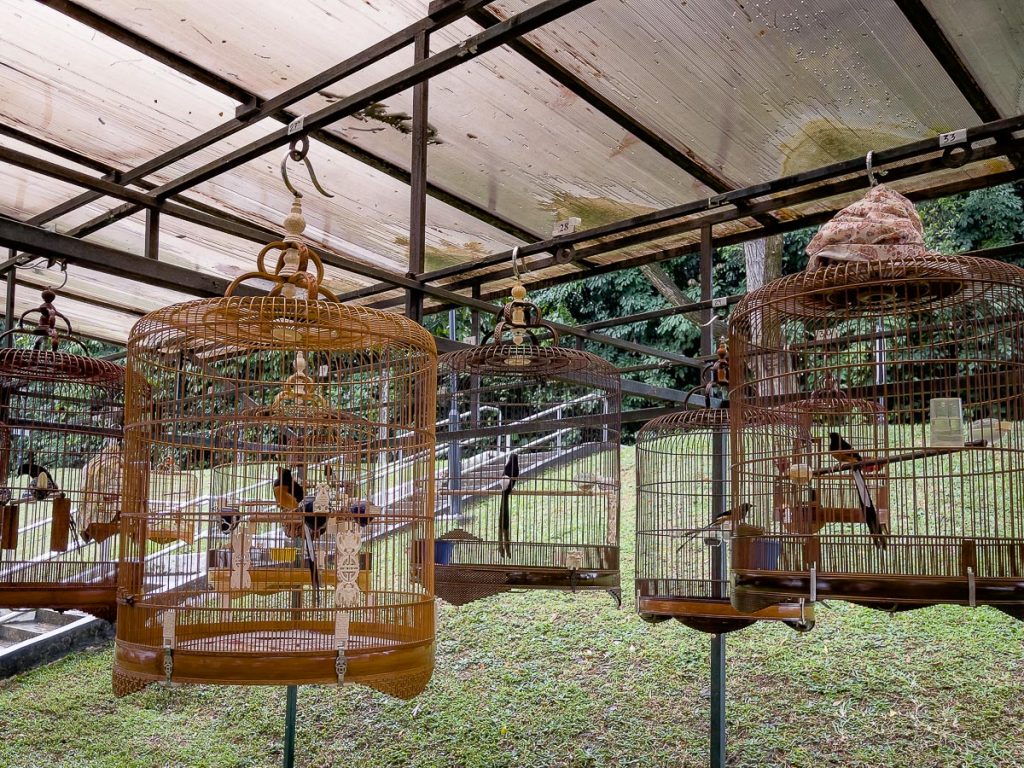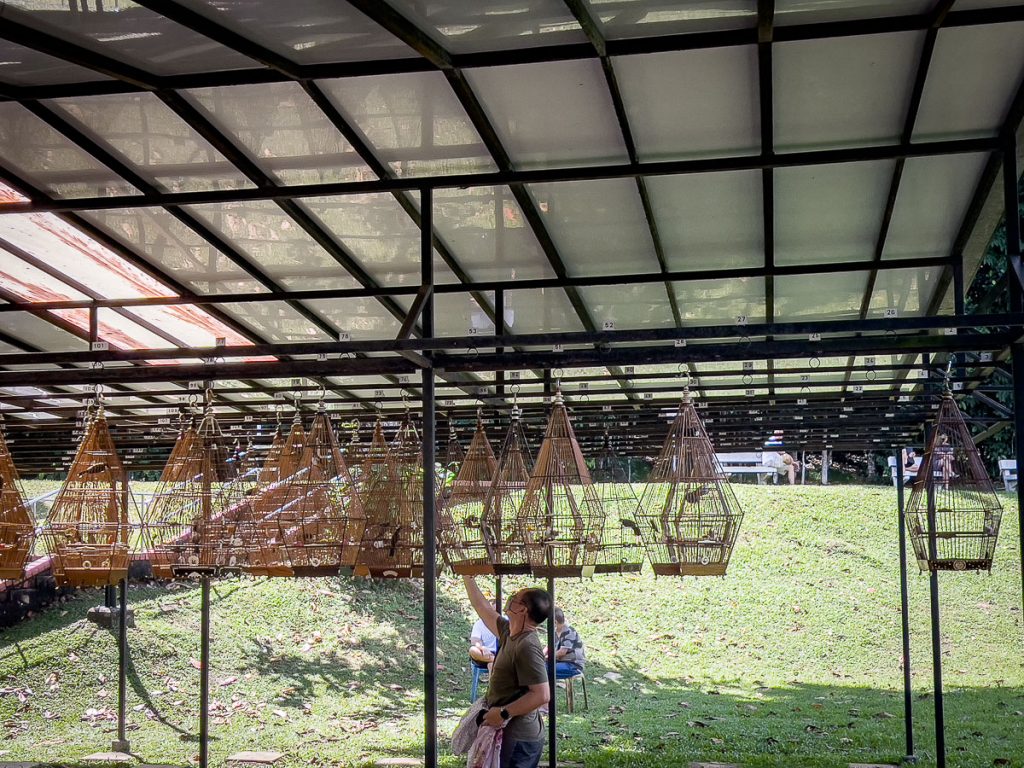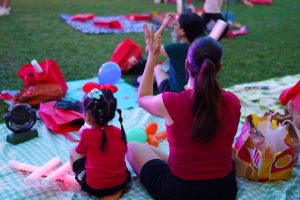All images by the author
It’s a quiet Sunday morning, and an unassuming corner of Ang Mo Kio Blk 159 slowly comes to life. The carpark near Kebun Baru Bird Singing Club starts to fill up with cars of all shapes, colours, models, and make, carrying precious melodious cargo—songbirds. They perch in cages, some more ornate than others, fleeting this way and that, as if warming up for an overture in three movements.
The nearby kopitiam buzzes with the convivial chatter of birdmen in an assortment of languages and dialects. They are mostly older folks—millennial birdmen are few and far between. The youngest are in their forties, and only a handful know of young adults with a keen interest in songbirds—if any at all.
I walk over to 57-year-old Malik, sitting on a red plastic chair, gazing up at his prized birds in their cage. With one hand clutching a raffia string attached to a metal tin cup full of kopi (the beverage of choice, it seems for many birdmen), he regales me with the stories he heard when he was a novice birdman, wet behind the ears, and new to the world of feathered crooners.
“More than 30 years ago, people used an invisible leash to catch wild birds. They put a trained songbird and birdseed near the trap to lure these wild birds. But now illegal already, most people breed their own birds instead.”
Though the songbirds appear to be cheerfully domestic, this nugget of information from Malik reminds me that songbirds are indeed, wild. I wonder then if these birds—even those bred in captivity—could live a happy, healthy life while crooning in a cage.
Nowadays, the bird-singing community faces an existential challenge: How will the tradition continue? With a dwindling number of birdmen in their teenage years and 20s, this hobby could be lost in the years to come. The potential extinction of this hobby looms on the horizon, and I wondered, if it were to continue—can these birdmen and their songbirds coexist with our modern ideas of animal welfare?

A better tomorrow, or worse?
Minutes before the bird-singing contest starts, a horde of bird owners fill up the arena. An audience of other fellow songbird enthusiasts take their seats on the pavement and plastic stool. Some resort to standing and milling around, others crouch on the grass path.
Amongst the crowd, I catch glimpses of several younger faces. In their early 30s, these apprentice birdmen reflect a glimmer of hope in the narrowing future of this tradition.
Keshore, a 30-year-old birdman, lives with more than 20 pet birds in an HDB flat with his wife. His face beams with pride when he talks about his songbirds—his vast collection includes twelve jambul birds (known as Red-whiskered Bulbul) and the matah puteh (known as Swinhoe’s White Eye).
Still, however much he loves them, rearing this many songbirds is a massive responsibility for Keshore. When he travels overseas, he must ensure that someone is available and qualified to care for his birds.
“These birds need to have their dedicated bathing time, adequate sunshine, and food. Different birds eat different types of food, and each bird has their own character,” Keshore explains. “Easily, they will take up two to three hours of your time every day.”
Songbirds demand a lot from their owners, some of whom work nine to five jobs.
After realising that he needed more time to care for his birds properly, Keshore left his full-time job as a ship surveyor to be a freelance renovator.
“If you work eight to five, you will come home at 5 p.m., and if you keep a lot of birds like me, you won’t have the time to take care of your birds. I am very passionate about this; that’s why I try to find the time.” He notes that the time commitment is a significant deterrent for aspiring birdmen.
Malik, another birdman I spoke with on another visit, knows a few NSmen who keep pet songbirds. However, these teenagers tend to prefer keeping their birds in their HDB flats and would only bring their birds out to bird-singing corners during public holidays.
With the weekends being the only spare time for NSmen, understandably, they prefer spending off days at home. “A lot of us here are retirees already. We can come anytime because we have the time,” Malik shares.
Surprisingly, Keshore tells me that keeping songbirds at home is easier than one might imagine—at least from a considerate neighbour’s perspective. By nature, songbirds are loud. With the volume reverberating from more than 20 birds at Keshore’s house, it’s a surprise that he hasn’t received noise complaints from his neighbours.
Keshore chuckled at his luck in finding a haven for his raucous hobby. “The previous owner also kept birds. So it’s always been a very noisy flat.”

A sign of the times
A bird-singing pageant is in progress. A few men pace in front of a sheltered area with a clipboard and pens in their hands. Their gazes dart quickly between the cages of white-rumped shamas as they flutter around, nestled underneath a sheltered area.
After several minutes of quiet pondering, they start scribbling on their clipboard. To the left of the sheltered area is a staircase, where a few senior birdmen huddle, calmly observing the scene below. One of them is Jerry, a 63-year-old birdman, who gives me a warm smile as our eyes meet.
63-year-old birdman, Jerry, concurred with Keshore’s assessment that there are safe spaces for songbird owners. Some estates, he shares, are not as forbearing towards the bird calls.
“In these newer estates like Punggol, Sengkang, and Hougang, you cannot keep birds because a lot of younger residents will complain. But most of the residents in the older HDB estates, like Woodlands, Choa Chu Kang, Ang Mo Kio, are from the older generation, so they understand the significance of this hobby,” he said.
Jerry went on to explain that due to noise complaints by residents, some bird-singing corners were shut down by the government a few years ago.
One such casualty was the Bukit Panjang bird-singing corner. It was one of the last of its kind, following the flurry of forced closures due to the resurgence of the bird flu disease two decades ago.
Jerry added that the physical disappearance of bird-singing corners further dissuades aspiring birdmen from participating in the contests. Such competitions are the social components of the hobby, where the tradition is passed down between generations outside of the family home.
Perhaps the existential issue facing this cultural tradition is one of change, not extinction. The nature of the hobby seems to have shifted from being community-centric to one enjoyed more privately within the confines of one’s home.
Inevitably, singing corners and competitions could be less popular in years to come, drastically changing the face of bird-singing for the next generation of birdmen.

A Pandemic on Bird-singing: A fearful or reassuring change?
Elsewhere, flocks of songbird owners congregate around a standing whiteboard with green-coloured A4 sheets blu-tacked to it. On these A4 sheets are the scores their pets racked up and the shortlisted birds that made it through to the next round.
After a glance at the scoreboard, some birdmen, appearing slightly dispirited, proceed to unhook their caged pets from the sheltered area before covering them with a bird cage cover. With the caged pets at their side, these songbird owners begin searching for a nearby spot to watch the rest of the competition.
“When there’s a competition here, you need to come earlier to get a parking slot,” Malik tells me. “This week, because of Hari Raya, it’s already less crowded than normal. Some of my friends are visiting their relatives, so they are not here today.”
Malik also mentioned that he sold his songbirds to friends during the COVID-19 period.
“My previous birds were very expensive, but I sold them for cheap. I like to hang my birds outside and see my friends, but at that time, I couldn’t bring them out or do anything. Keeping these birds becomes very boring and has no purpose.”
For senior birdmen like Malik, who view bird-singing as a communal activity, the pandemic’s isolation negatively impacted their social lives. But thankfully, they weren’t disheartened by the years of arduous restrictions—many chose to repurchase new songbirds as soon as the restrictions were lifted, Malik shares. Today, some of the birds he keeps are also a gift he received from his friends.
Surprisingly, the pandemic has unfurled renewed interest in songbird-keeping among many younger Singaporeans—just like keeping plants did for millennials.
A songbird breeder, who prefers not to be named, shared that many Singaporeans bought their first songbird during the Circuit Breaker period in an effort to pass the time at home.
“But nowadays, COVID restrictions have loosened up, and a lot of people are returning to work in their office. So, many of them sell their jambul, matah puteh, or they put them up for adoption.”

Our feathered pals seem happy, but are they?
While bird-singing might be a popular hobby, underground poaching is still a concern, even though wildlife poaching has already been banned in Singapore.
Between 2019 and 2021, the Animals Concerns Research and Education Society (ACRES) was alerted to 75 wild bird poaching activities.
These underground activities have revealed an unsavoury part of the hobby: some birdmen simply prefer wild songbirds, allured by their irregular singing tempo and raw tunes.
A 2022 survey by Straits Times showed that 17% of 114 hobbyists prefer wild songbirds, driving demand for unsustainable bird poaching. Many poachers have resorted to cruel methods, like using another songbird to attract wild songbirds or placing wet glue on a tree branch where a wild songbird would land.
However, some birdmen, like Jerry, prefer the bred counterparts. They believe the voice of a bred songbird can be better, as these birds would be trained from a younger age for bird-singing competitions.
Poaching activities aside, even the songbirds from local bird shops or online have obscure origins. An article by The Straits Times reported that some local bird shops are still selling wild-caught birds, despite the government’s stance on unsustainable trade practices. As a result, it’s difficult for newcomers to get involved on the commercial end.
“Nowadays, it’s very difficult, almost impossible, for new bird shops to get a licence. Government is very strict,” Jerry laments. “Unless you take over someone else’s bird shop. But those shops still need an AVA permit to import songbirds.”
Ultimately, this stance is a net positive for animal welfare. A bird shop employee divulged that there are ongoing conservation efforts by a local avian specialist, Dr Jessica Lee, to educate songbird hobbyists on how to better protect the wild songbirds.
Some birdmen in the community also believe that licensed breeding practices may help with songbird welfare since it can help revive endangered breeds like the matah puteh and sparrow.


Doing right by our songbirds
Still, not everyone is convinced that the keeping of songbirds can ever be sustainable.
“Birds don’t belong to cages; they are supposed to be flying around,” shares Joe Kam, a wildlife specialist who has worked in the rescue industry for five years.
He explained that keeping songbirds in their cages does not fulfil the five principles of animal welfare that are applied to animals in captivity: freedom from hunger and thirst, freedom from discomfort, freedom from pain, injury and disease, freedom from fear and distress, and freedom to express normal behaviour.
When songbirds are kept in captivity, Joe notices they are prone to fear and distress. “Every time someone comes near the cage, you can see that they will try to flee because they don’t know what’s coming. They are stressed.”
He also observed that caged songbirds are unable to express their normal behaviour of flying since they can only dart around in cages. Furthermore, songbirds are not free to select their climate.
“In the wild, the bird can choose to fly away to a cooler spot if it gets too hot. But nobody knows if the temperature where you hang the birdcage is optimal for the birds,” Joe explains.
With other aspects of the bird-singing tradition, like the bird-singing contests, Joe is uncertain whether pet songbirds––mostly male due to their more vocal nature––are comfortable when singing near each other. In the wild, he noted, they sing to declare territory.
“Even if the bird calls sound nice to us, it could be a call of distress rather than a happy song since we don’t understand the bird language.”

A tradition forever preserved—hopefully
Despite the palaver involved with caring for songbirds, Keshore believes the bird-singing community will not end. Even if the social component of the hobby were to wane slightly, it seems quite certain that the tradition will persevere in the near future.
But when held to our modern conception of what’s fair and healthy, can this practice pass muster in its current iteration? It appears to be unlikely, with the problem of the songbirds’ welfare still unsolved.
Take it from Keshore, who followed his father into bird-singing. “Someone’s son, the next generation, will take over. There will definitely be people who keep this hobby going.”






